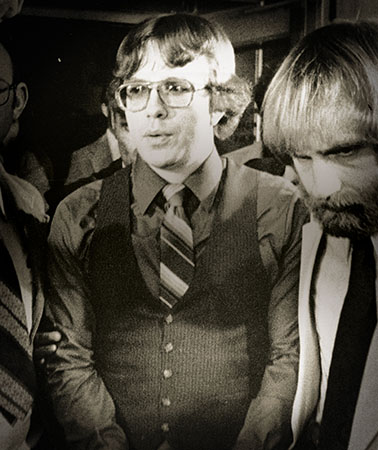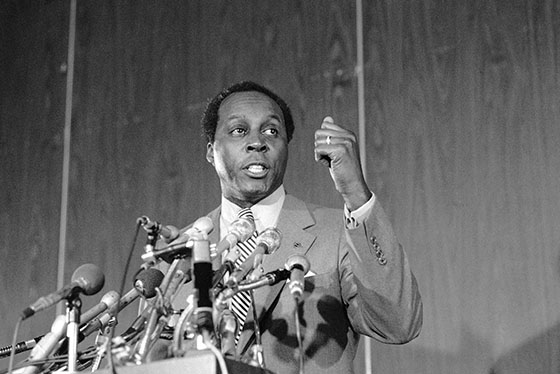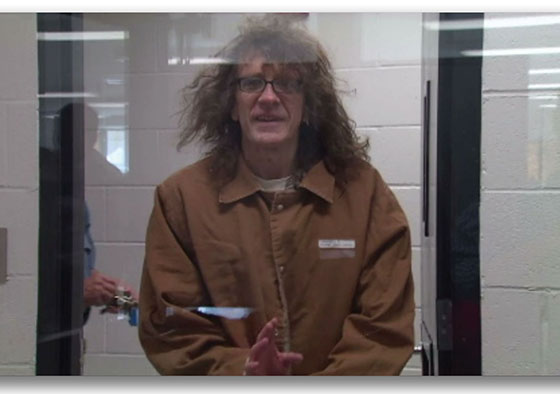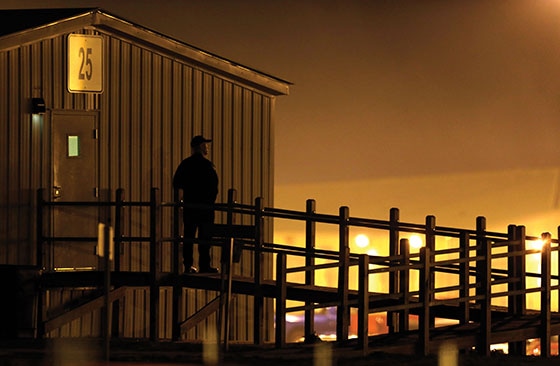Murder's Price
Joseph Paul Franklin was America's most notorious racist serial killer. But shortly before he was put to death last November, he announced a major change of heart.
BONNE TERRE, Mo. — Shortly after racist serial sniper Joseph Paul Franklin was executed here in the cold, pre-dawn darkness of Nov. 20, an intense debate erupted on the white nationalist Web forum Stormfront: Was the 63-year-old drifter, who was suspected of killing as many as 20 unarmed men, women and children, a hero of the separatist cause or a curse?
The debate raged for days.
“Franklin should be getting a community service award rather than an execution,” “Disappointed American” posted to the forum just hours after Franklin was pronounced dead at 6:17 a.m. from a lethal injection of pentobarbital.
“He can burn in hell for all I care, one JPF causes more damage to our chances of succeeding than any Hollywood propaganda piece could,” “Pat88” wrote.
Comments pro and con poured in and eventually took up 15 pages. But as Don Black, the former Alabama Klan leader and founder of Stormfront, pointed out, “I may be the only person here who actually knew Franklin.”
“I’ve been contemplating how my life would have been different had he remained the only ‘White Nationalist’ I’d ever met,” Black wrote. “I’d have quit in disgust. I had just turned sixteen, and maybe I could have then led a ‘normal’ life.”
It is remarkable that there could be any debate about Franklin’s deeds at all. From 1977 to 1980, the Mobile, Ala., native roamed the country, killing people at random as part of his delusional “mission” to spark a race war.
The late William Pierce, founder of the neo-Nazi National Alliance, certainly admired Franklin. Pierce attempted to immortalize Franklin’s racist killing spree by dedicating to him the 1989 novel, Hunter, which Pierce authored under the pseudonym Andrew Macdonald. The book depicts a character much like Franklin, who hunts down and murders interracial couples and government officials. Pierce called Franklin, “the Lone Hunter, who saw his duty as a White man and did what a responsible son of his race must do, to the best of his ability and without regard for personal consequences.”
While at least one Stormfront poster quoted Pierce’s dedication as evidence that Franklin was a hero, Black wrote, “I could never imagine why Pierce dedicated a book to him, since he must have known him.”

Franklin mostly targeted black men and boys and interracial couples. Yet, it was the 1977 sniper slaying of a 42-year-old white man, Gerald Gordon, coming out of a synagogue after a bar mitzvah in suburban St. Louis, that resulted in Franklin’s only death sentence.
Franklin’s execution after 33 years behind bars was the last killing in a life twisted and consumed by murder, childhood abuse, racial hatred and madness. “I was mentally ill when I was out there, man, I mean, I was just completely out of control, to be quite honest,” Franklin told the Intelligence Report in a series of telephone interviews in the last three weeks of his life. “That was not me out there in the streets, doing that crap. I would not even think of doing that stuff again.”
He went on to renounce his racist past and anti-Semitic beliefs and expressed remorse for his crimes. His statements of regret generated more comments – and considerable disappointment – on the Stormfront forum. Franklin was criticized for his “pussified recanting of his racial views,” for “groveling around for a little more time locked in a box,” and for being “a p---- and a traitor” for recanting.
But a poster identified as “HenryV” was less judgmental of the remorseful racist: “It’s easy to call him names from behind a computer screen but imagine the hell, not to mention the intimidation that man has faced in jail. We don’t know how we might act faced with the same enemies. Were any of the Nazis at Nuremburg sieg heiling and remaining defiant[?]”
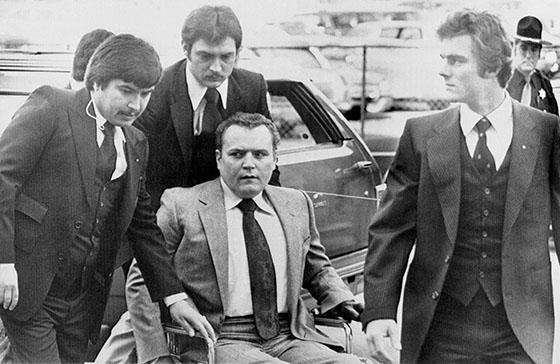
A Killer’s Dreams
The slaying of Gerald Gordon went unsolved for nearly 20 years until Franklin, with a Grim Reaper tattoo on his arm, confessed in 1994 while serving two life sentences in a federal prison in Illinois for slaying two young black men in Utah. The insanely superstitious Franklin said he admitted shooting Gordon because a dream instructed him to tell.
“I was always having dreams on the streets, telling me to do things,” Franklin said. “I always felt they were messages from God, so I would obey them.”
At a pre-trial hearing in 1997 for Gordon’s murder, Franklin told the court that his only regret was that killing Jews wasn’t legal. Franklin, who represented himself at the subsequent trial, asked the jury to sentence him to death. He flashed the jurors a thumbs-up when they followed his wishes.
“I had just totally been obsessed with Mein Kampf and Hitler and wanted to kill some Jews,” Franklin told the Report. “That was another thing that was crazy. That was obviously the work of somebody who was mentally ill, because who would want to go around shooting somebody worshipping at a synagogue? I just cannot imagine myself committing a crime like that anymore. I have actually come to the conclusion over the years, a person that is anti-Semitic, that in itself is a sign of mental illness.”
After interviewing Franklin in person for more than six hours in 1996, Dr. Dorothy Lewis, a New York City psychiatrist, concluded, according to New Yorker magazine writer Malcolm Gladwell, that Franklin was a paranoid schizophrenic, “a psychotic,” Gladwell wrote, “whose thinking was delusional and confused, a man wholly unfit to stand trial at this time.”
Lewis reached the same conclusion in 2003 and again in 2013 after reviewing her records, reports and interviews with Franklin’s relatives — findings Franklin’s lawyers cited in their unsuccessful petition to the governor seeking commutation or reprieve of his death sentence. “Dr. Lewis finds Mr. Franklin to be,” according to the petition, “a chronically paranoid schizophrenic person who suffers psychotic behaviors such as blasphemous thoughts, auditory hallucinations, and delusional beliefs (such as the belief that he is a Nazi and a Jew).”
The prolific serial killer has been that way, the petition added, since his abusive adolescence. Franklin and his three siblings were repeatedly and brutally beaten by their parents. Franklin, his older sister Carolyn told the Report, “always got the worst of it.”
Their parents cursed, screamed, yelled, beat and “knocked us around unmercifully,” she said in a written statement seeking clemency for Franklin. There was plenty of poverty and almost no love in their home in the all-white public housing projects of Mobile, where Franklin grew up.
Carol said as a result of their upbringing, Franklin and her other siblings were psychologically damaged. Their younger brother Gordon, she said, has been in and out of mental institutions. “As mentally ill as my siblings are, I did not remain unscathed,” she said in the statement. “I know that I have Post Traumatic Stress Disorder. Just writing about our childhood has caused me undue anguish and tears untold. I have been depressed most of my life. I have undergone psychiatric treatment for these things.”
Franklin, however, told the Report that he had cured himself of mental illness by meditating and reading books during his nearly three decades in solitary confinement, the last 15 with a death sentence hanging over him.
“It’s called bibliotherapy,” he said.
‘Focusing on Race-Mixers’
All told, Franklin was convicted of killing eight people, from Wisconsin to Utah. Gerald Gordon was the third person he killed. His first killing was of a young interracial couple in Madison, Wis., in August of 1977. Franklin was obsessed with black and white sex. “I still think miscegenation is wrong,” Franklin said. “But now I know it’s none of my business.”
His last killing occurred almost exactly three years after his first and the start of his “mission.” It happened on the evening of Aug. 20, 1980, in Salt Lake City when he shot and killed two young black men – David Martin, 18, and Ted Fields, 20.
“My goal at the time was just focusing on race-mixers,” he said. Franklin shot Martin and Fields from the tall weeds of a vacant lot shortly after nightfall because he saw them jogging around a park with two white teenage girls.
The two young men – a recent high school graduate and a college student who was the son of a minister – were not Franklin’s first choice to die that night. “I intended to shoot an interracial couple coming out of a convenience store,” Franklin said. “Then I saw two interracial couples jogging through Liberty Park. I swung the rifle around real quick to my left. I was able to get a shot off real quick and drop one of the blacks.”
To Franklin’s amazement, instead of running away, the wounded man’s friends grabbed his arms and tried to pull him to safety.
“I couldn’t understand that,” Franklin said.
He quickly racked the action of the rifle, peered through the scope and “dropped the second black guy.”
“I then emptied the gun into both guys while they were lying there,” he said. “I figured I should complete the job.”
One of the white girls who watched her friends get gunned down that night is now a 49-year-old grandmother named Terry Jackson-Mitchell. She still carries a scar from when a bullet tore through one of the young men and a ricocheted off the pavement. Mitchell told the Report that she had forgiven Franklin but still wanted him to be executed, to put him out of his lifetime of suffering.
Still, 10 days before his scheduled execution, Mitchell sent Franklin two books about spiritual healing and forgiveness. She also agreed to speak to him over the phone.
The conversation rattled her.
“He said he was glad he didn’t kill me,” Mitchell said. “He said he was sorry for the incident. ‘The incident’ is what he called what he did.”
Franklin called Jackson-Mitchell two days before his execution. She said he sounded scared, scattershot and seemed afraid of dying as he apologized one more time. “He is as remorseful as he is capable of being,” she said. “He said he is so grateful he didn’t kill me and that he was mentally ill when he did it. I have made peace with that information.”
Nothing he said, however, changed her mind or her heart about his need to be executed, despite what she said was his childhood of “incredible neglect and abuse.”
“I think it did stunt his brain growth in some way,” she said. “It changed who he could have been. He certainly lacked the ability for empathy. But how would he know what that looks like without ever seeing it in his moments of helplessness as a child?”
Over the years, Franklin also admitted to shooting and paralyzing Hustler magazine publisher Larry Flynt in Georgia in 1978 and critically wounding civil rights leader Vernon Jordan in 1980 in Indiana. Franklin was never tried for shooting Flynt and was acquitted in federal court for the sniper attack on Jordan. The jury in that case, Franklin said, made a mistake.
He said he shot Flynt because the publisher had featured an interracial couple in his magazine. Flynt, a longtime opponent of the death penalty, put aside his personal pain and near death at the hands of Franklin to speak out against Franklin’s execution, saying recently that capital punishment was not about justice, but vengeance. Flynt, with the help of the American Civil Liberties Union, even went to court, hoping to stop the execution.
Nevertheless, Flynt wrote in The Hollywood Reporter that he would love one hour alone with Franklin “with a pair of wire cutters and pliers, so I could inflict the same damage on him that he inflicted on me.”
Franklin told the Report that he appreciated Flynt’s opposition to his execution. “But I don’t like that he wanted to torture me,” he said, chuckling.
In the last few weeks before his scheduled execution, Franklin seemed calm and relaxed and even joked during his interviews with the Report. He said while he was “pulling out all of the stops” to save his life, he was not afraid to die. “I strongly believe in reincarnation,” he said, adding that he had long ago “repented his sins” and asked “the Lord for forgiveness.”
But there was no doubt that he wanted to live, even if that meant spending the rest of his days locked up alone in a cell in solitary confinement, as he had been for his own protection for most of his three decades behind bars. He was stabbed 15 times in a federal prison in Illinois by a group of black inmates in 1982, trying to carry out an execution of their own.
‘Pray for My Daddy’
Franklin crisscrossed the country, randomly killing strangers for three years before he was captured in 1980. He left behind dozens of grieving family members. He also left behind a tiny victim of his madness named Lori, his only child.
Lori has been haunted by her father’s absence and his deeds all of her own troubled life. “He had a problem with alcohol, I have a problem with alcohol,” she said. “It’s in the genes.”
Lori was 1 year old when Franklin was arrested. “I knew he was in prison for killing blacks,” Lori told the Report, wiping away tears as she picked at her lunch recently. “I didn’t know how many. I didn’t know any details until I got to be 18. Then I looked it up for myself.”
Lori said she has never hugged her father or seen him in person since his arrest. She has seen him several times on television programs about notorious serial killers. She said she meant to visit her father in prison over the years, “but something always came up.”
Franklin said he put his daughter on the list of five friends and family members he is allowed to invite to witness his execution. But Lori said she would not and could not go – emotionally or financially. “We’re about as poor as you can get,” she said.
Still, she said, Franklin did his best to stay in touch through letters and telephone calls when she was growing up. She said he often sent her money when he had a prison job before he was sent to death row in 1997. “Despite him being in prison all this time, he really tried being a dad as best he could,” she said. “A lot of guys don’t even do that and they’re out here.”
Lori said she loved her father and was praying for a miracle so that his life would be spared, at least long enough for him to meet his great-granddaughter through the thick glass of a prison visiting room. Lori was a teenage mother and so was her daughter.
About a week before Franklin’s scheduled execution, Lori talked with her father on the telephone for the first time in nearly two years. She said he was “becoming too crazy” in solitary confinement and “I needed to keep my distance.”
But time was running out. When he called, she answered.
“The first time I ever heard him laugh was yesterday in my whole life,” she said. “He apologized for not being a good father to me and asked me to please forgive him. Of course, I said yes.”
Still, Lori has kept who her father was a secret from almost everyone she knows.
“When I was in school everybody would ask me about my dad and I’d lie,” she said. “That’s when he was locked up in Illinois. I’d say he was a businessman in Illinois. Only a few choice friends know about my daddy, a couple of them are black. I used to think there was something wrong with me because I had his blood in me. Sometimes I still think that. I told a black friend several years ago. I asked him if he thought any different about me. He said, ‘No, you didn’t do it.’”
The other day, Lori announced on her Facebook page who her father is. She is tired of hiding. She is tired of being one of Joseph Paul Franklin’s victims.
“I pray for my daddy,” she said. “That’s all I can do.”
As Lori prayed for her father’s shattered soul, the Stormfront debate about Franklin’s place in white supremacy raged on.
“He was simply another victim of the failed policy of integration,” “Freedom lover” posted. “Let his death be on the heads of every liberal asswipe who supports white genocide.”
“He was a coward, who when he wasn’t preying on those weaker than he was, shot people from ambush,” “FreeWhiteMan” wrote. “Nothing manly about him at all.”
“Garryowen” posted that all Franklin managed to do “is demonize those on the Right – as if we needed any more of that.”
“I’m sure he’s in Valhalla, drinking mead from the skulls of his victims,” “Voncyril” wrote.
“I doubt if he made it there,” Don Black fired back, “particularly after telling the SPLC Jews we were all ‘mentally ill’ for not liking Jews, hoping to save his hide a little while longer.”
________________________________________________________________________
For more information about William Pierce, see sp.lc/william-pierce.


